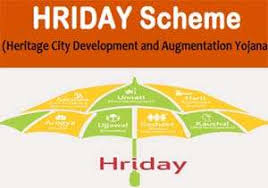HRIDAY Scheme – National Heritage City Development And Augmentation Yojana – Notes For W.B.C.S. Examination.
HRIDAY scheme called National Heritage City Development and Augmentation Yojana was launched by the Ministry of Housing and Urban Affairs on 21st January 2015.Continue Reading HRIDAY Scheme – National Heritage City Development And Augmentation Yojana – Notes For W.B.C.S. Examination.
This scheme was introduced to preserve and revitalize the rich cultural heritage of the country. HRIDAY scheme aims in the conservation of heritage, urban planning and in increasing the economic growth of the heritage cities. The National Heritage City Development and Augmentation Yojana emphasize on the accessibility, security, safety, livelihood, cleanliness and faster service delivery in the heritage cities.
HRIDAY scheme was launched on 21st January 2015 for the development of heritage cities. This scheme aimed to preserve and revitalise heritage cities of India to reflect their unique character. It also encourages the development of an aesthetically appealing, accessible, informative and secured environment in heritage cities. The HRIDAY Urban Development Scheme has been implemented by the Ministry of Housing and Urban Affairs and is being implemented with quantifiable goals similar to the implementation of the Smart City Scheme on a mission mode.
The focus of HRIDAY is the development of core heritage infrastructure by the Ministry of Housing and Urban Affairs for areas near heritage sites approved after identification by the Ministry of Culture. Development of infrastructure like approach roads, drainage, footpaths, electrical wiring, landscaping, sanitation, street lights, water supply, waste management and allied citizen services such as tourist conveniences, security etc. are some of the major focus areas of the scheme.
HRIDAY completed 4 years in January 2019 and has an outlay of funds pegged at Rs.685758 crore. The initially planned outlay was Rs 500 crore. Out of this projects worth about Rs 422 crore have been approved, and projects worth Rs 140. 14 crores have been completed.
HRIDAY Scheme Cities List
Below are the cities that are listed under the HRIDAY Scheme:
- Ajmer
- Amravati
- Badami
- Gaya
- Mathura
- Puri
- Varanasi
- Velankanni
- Warangal
- Dwarka
- Kanchipuram
- Amritsar
Objectives of HRIDAY
The official HRIDAY Scheme statement sets out the following quantifiable goals for urban development in heritage cities:
- Planning, developing and implementing infrastructure keeping in mind sensitivities of heritage, including service delivery and development of infrastructure in core areas of historic cities.
- Preserve and renovate heritage so that tourists can connect with each heritage city’s unique nature.
- Develop a heritage asset inventory of cities documenting built, cultural, living and natural heritage as a basis for urban planning, growth, planning of services and their delivery.
- Enhancement of basic services focussing on sanitation like public toilets, water taps, security like street lights and in improving tourist facilities.
- Create linkages between cultural facilities and tourism along with the conservation of heritage and capacity building of local industries based on heritage.
- Adaptive maintenance of urban heritage, including rehabilitation using appropriate technology for retrofitting historic buildings with modern conveniences. Establishment of public-private partnership for preserving and maintaining historic buildings is also part of this goal.
- Promotion of economic activities to enhance avenues of employment among people living in and around the heritage sites. This includes skill development among them and making public and cultural spaces accessible.
- Making cities informative using modern ICT tools and making cities secure using modern security devices like CCTV etc.
- Increase access to heritage sites by developing roads, adopting the universal design, GIS mapping of historical locations and building a digital record of the heritage etc.
Please subscribe here to get all future updates on this post/page/category/website


 +919674493673
+919674493673  mailus@wbcsmadeeasy.in
mailus@wbcsmadeeasy.in







































































































